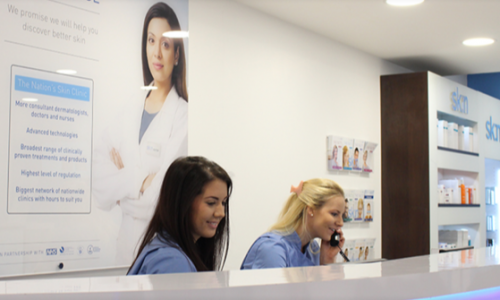Mole Removal Guide

Moles: The Causes, Symptoms & Treatments
What Causes Moles?
Moles are small brown or black patches that form on the skin. They can be flat or raised and some even have hair growing from them. They are usually circular or oval in shape. Moles are caused by skin cells that form in clusters, called ‘melanocytes’, which produce the colour or pigment in your skin.
We offer mole mapping and mole removal services with Doctors across our nationwide clinics. Mole treatments would need to be booked over the phone or by filling a form to ensure we book you in with the right medical expert. We start you on your journey with sk:n clinics by booking you in for a consultation.
During your consultation our medical experts will talk through the right treatment for you, go through our prices and ensure that you have the option to book the treatment with us should you wish to after consultation.
Mole Removal Treatments
Laser Removal
If your mole is small, laser treatment can be used to remove it. Light radiation is used to break down the pigment within the mole during laser mole removal. Because there is minimal chance of scarring, this procedure is a suitable choice for removing a mole off the face.
It should take about 30 minutes to complete a laser mole removal appointment. Bursts of laser radiation are aimed at the mole during the treatment, breaking down the skin cells that make it up. Because of the laser’s precision, only the mole is removed, leaving the surrounding area intact and healthy.
Shave Removal
Under local anaesthetic, moles that protrude from the skin can be ‘shaved’ away (this numbs the treated area). This is normally done with a scalpel and is a reasonably simple and painless procedure.
Your doctor will inject a local anaesthetic, which will not only relieve pain, but will also cause the mole to rise upwards, making removal easier. They’ll then use a sharp razor to shave the growth off in many horizontal cuts. While the cuts are being made, you may feel a tiny sensitivity, but you should not be in any discomfort.
This simple operation is far less invasive than a full-thickness skin excision because it doesn’t require sutures or stitches. After the mole has been removed, it will be submitted to a laboratory to be thoroughly examined for any abnormalities or malignancies.
Excision Removal
Some moles, especially those that are bigger, may require excision. This operation is done with a local anaesthetic and ends with a tiny suture in the skin.
Mole excision, also known as a full-thickness skin excision, removes unsightly moles all the way down to the subcutaneous fat (deepest layer), ensuring that the growth will not return.
This operation normally only requires a local anaesthetic, after which the entire mole and a tiny portion of the surrounding skin will be removed, and the mole will be taken away to be examined by specialists in a laboratory.
How Do Moles Form?
Melanocytes (skin cells) develop in clusters or clumps, resulting in moles. Melanocytes are cells that are found all over your skin and create melanin, the natural pigment that gives it colour.
Are Moles Dangerous?
Most moles are harmless. However, sometimes they can develop into a form of skin cancer called malignant melanoma. If you notice new moles or existing moles that have changed shape, colour, size, height, or if they become irritated or start bleeding, then it’s important you go to your GP immediately to get them checked and removed if necessary.
Is Getting A Mole Removed Painful?
You shouldn’t feel any pain or sharpness during mole removal because you’ll be given a local anaesthetic before the process.
When Should A Mole Be Removed?
A doctor will be able to determine whether a mole needs to be removed. Sometimes they will take a biopsy to find out whether it is cancerous before removing it. Many people have moles removed for cosmetic reasons, or for comfort if it’s situated in an awkward place.
Who Can Remove My Mole?
Mole removal should only ever be carried out by a qualified doctor. The NHS has cut back on many services in recent years, including mole removal treatments. According to current guidelines, a mole will not be removed on the NHS for purely cosmetic reasons and instead must be done through a private provider.
What Is The Mole Removal Procedure?
The mole removal procedure differs depending on what method your doctor has chosen for you. All procedures are pretty straightforward and relatively painless.
Why Do New Moles Appear?
Most moles develop in early childhood and up until the age of about 20, but some people develop moles later in life. The development of new moles is linked to sun exposure and new moles can in some cases be a sign of skin cancer.
Are All New Moles Skin Cancer?
It is normal to develop new moles and most are not harmful or cancerous – but a new mole should always be examined by a doctor, particularly if you are over the age of 25.
How Can I Prevent Moles?
Moles are a normal skin characteristic and most people will have between 10 and 40 moles when they reach adulthood. If you want to avoid the development of new moles, you should wear an effective sunscreen and try to cover up in the sun.
Moles & Pregnancy
It is normal for moles to get slightly darker during pregnancy. This is due to hormonal changes which can affect the pigment in your skin. If a mole has changed size or texture, consult your GP immediately.
Mole Removal Cost
The mole removal price will vary depending on the best mole removal for your desired result. Consultations start at £150.
Related Articles

08
Apr 2024

08
Apr 2024
Request a callback
One of our friendly sk:n advisors will call you to book your consultation.
- More than 450 consultants, doctors, nurses and medical practitioners
- Regulated by the Care Quality Commission, Health Inspectorate Wales and Health Improvement Scotland
- Partner of the NHS
- Rated excellent by our clients on Trustpilot
- Strict safety and care protocols




